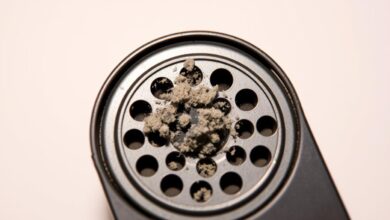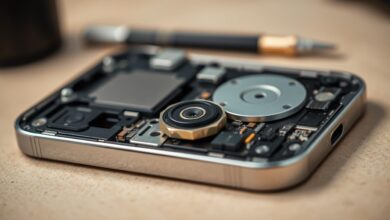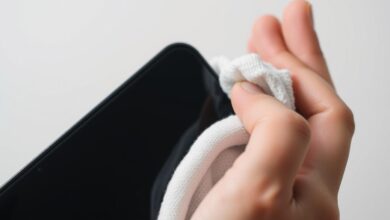Sound to Get Water Out of Your Phone
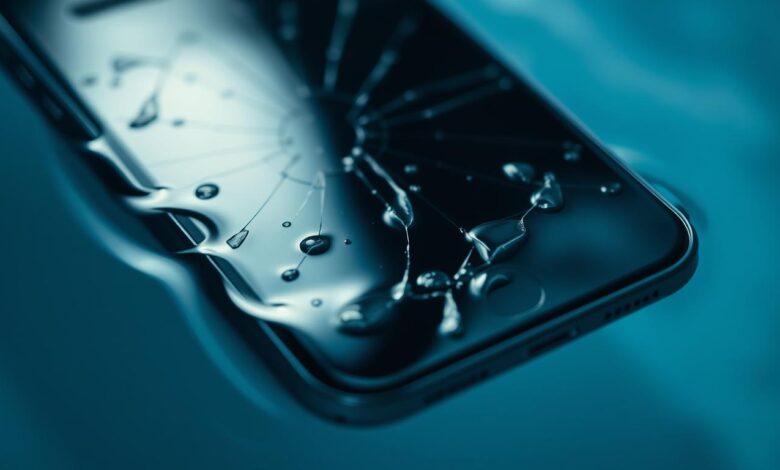
It’s really frustrating when your phone gets wet. You need to find a way to dry it out fast. One method people are talking about is using sound waves to get rid of the moisture.
I’ll look into using sound to remove water and give you a step-by-step guide. We’ll talk about how well this method works and its limits.
Key Takeaways
- Using sound waves can help remove water from your phone.
- A step-by-step guide is provided to help you dry out your device.
- The science behind this method and its limitations will be discussed.
- Alternative techniques for drying out your phone will be explored.
- Precautions to prevent water damage to your device will be highlighted.
Understanding the Problem of Water Damage
Water damage is a big problem for smartphones. It can make phones not work right anymore. I’ll talk about the issues with water damage, its signs, and how it harms phone parts.
Why Water Damage is a Concern for Phones
Water damage worries us because it can cause corrosion and harm phone parts. This can lead to short circuits and parts not working right. For example, if a phone gets wet, the risk of damage to the circuitry goes up a lot.
Experts say it’s important to act fast to lessen damage. They suggest following the 8 steps to save your phone from water.
Common Symptoms of Water Damage
Spotting water damage early is key to saving your phone. Look out for:
- Corrosion on the internal parts
- Short circuits that make the phone not work right
- Screen problems, like it not responding or looking different
- Audio issues, like sound not coming out right or not at all
Seeing these signs early can help you act fast to prevent more damage.
How Water Affects Phone Components
Water can harm many parts of a phone, like the circuit board, battery, and screen. When water gets in, it can cause short circuits and corrosion. This can damage the phone for good.
Knowing how water affects phone parts is key to figuring out the best fix or drying method.
Sound Frequencies and Their Effects on Water
Removing water from a phone often involves sound frequencies. This concept is based on how sound waves interact with water.
Sound waves are vibrations that move through a medium like air or water. These vibrations can make water molecules move. This movement can help push water out of a phone’s parts.
How Sound Waves Work
Sound waves transfer energy through a medium. In water extraction, the medium is usually air. The sound wave’s frequency affects its pitch and energy.
Different frequencies have different effects on water. For example, high-frequency sound waves can create cavitation. This is when bubbles form and collapse, pushing water out.
Resonance and Water Movement
Resonance happens when sound wave frequency matches water’s natural frequency. This can make water move more, helping to remove it from the phone.
Understanding sound waves and water interaction can help extract water from phones. This method uses the physics of sound and liquids.
Can Sound Actually Remove Water from a Phone?
The idea of using sound to dry out phones is interesting. But what does science say? We need to look at the science behind it.
Scientific Evidence Behind the Concept
Research on sound and water is promising. Studies show sound waves can push water off surfaces. This might help fix water-damaged phones.
For example, a study found sound between 20 Hz and 20 kHz can remove water from phone speakers. To learn more, check out guides on how to get water out of your phone.
Sound waves work by creating pressure changes in water. This is based on acoustic cavitation. Sound waves make bubbles in water, which then pop out.
Key findings from relevant studies include:
- Sound frequencies in the range of 20 Hz to 20 kHz can be effective in removing water.
- The volume of the sound is crucial; it must be sufficiently high to dislodge the water without damaging the phone’s internal components.
- The duration for which the sound is applied can impact its effectiveness.
Limitations of Using Sound for This Purpose
While the idea is promising, there are big limitations. The type of water damage matters. Sound might not work for phones that have been underwater for a long time or have serious damage inside.
Some key limitations are:
- The risk of damaging the phone’s speaker or other internal components due to high-volume sound.
- The effectiveness of sound in removing water from various parts of the phone, such as the charging port or SIM card slot.
- The need for specialized equipment or apps to generate the appropriate sound frequencies.
In conclusion, sound might help remove water from phones. But we must know its limits and the science behind it.
Creating the Right Sound to Dislodge Water
To get water out of your phone with sound, you need to know the right frequencies. Sound waves can create vibrations. These vibrations can push water out of your phone’s speakers and openings.
The success of this method depends on the frequency used. Some frequencies work better than others to remove water.
Frequency Range That May Help
The range of 100 Hz to 2000 Hz is often effective. This range includes lower to mid-frequencies. It’s believed to create enough vibration to remove water without harming the speakers.
Studies and user experiences show that 165 Hz is particularly effective. But, it’s important to try different frequencies to see what works best for you.
| Frequency Range (Hz) | Effectiveness | Potential Use |
|---|---|---|
| 100 – 500 | High | Dislodging water from speakers |
| 500 – 1000 | Moderate | Clearing water from phone openings |
| 1000 – 2000 | Low to Moderate | Assisting in drying internal components |
Devices and Apps for Generating Sound
There are many devices and apps to help remove water from your phone. Online tone generators and mobile apps are popular choices.
Apps like Tone Generator and Frequency Sound Generator are available for download. They let you set specific frequencies and adjust the volume.
Online tone generators can also be used through a web browser. They offer a simple way to generate the needed sound frequencies.
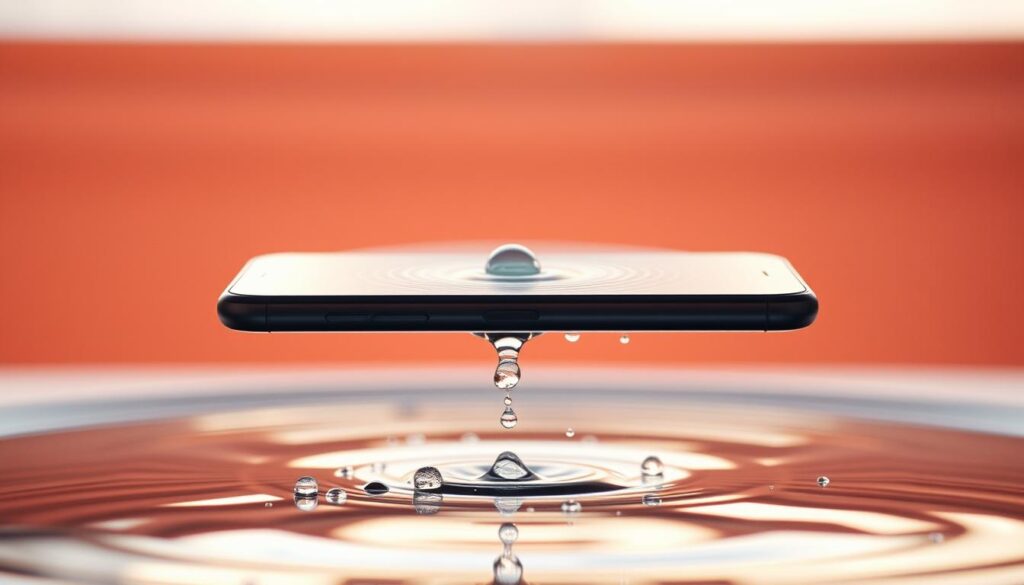
When using these tools, keep the volume low. This helps avoid damaging your phone’s speakers.
Step-by-Step Guide to Using Sound
Now, let’s look at how to use sound to dry a wet phone. This method is effective but needs careful steps. It’s important to prepare and execute it right.
Preparing Your Phone for Sound Treatment
Before starting, turn off your phone to avoid short circuits. Take out any accessories, SIM cards, and SD cards. This helps the drying process.
Pat the outside of the phone with a soft cloth to remove water. Act quickly to reduce damage. The sooner you start, the better your phone’s chances.
Optimal Volume Settings
The sound’s volume is key. It should be loud enough to push out water but not harm the speakers. Start with 80% of the max volume and adjust as needed.
Suggested Sound Clips or Frequencies
Choose the right frequencies for the sound treatment. Frequencies between 100Hz to 200Hz work well. Look for sound clips online or use apps that generate these frequencies.
Try a 165Hz tone or a sweep from 100Hz to 200Hz. Finding the right sound is crucial. Experiment with different frequencies to see what works best for your phone.
By following these steps and being patient, you can dry out your phone using sound. This method is part of a wet phone fix plan. Use it with other drying techniques for the best results.
Alternative Methods to Remove Water from Phones
If your phone got wet, you might look for ways other than sound to dry it. Sound can help, but other methods work well too.
Traditional Techniques for Drying Out Phones
There are old ways to dry a wet phone. Using desiccants or silica gel packets is one. Silica gel packets soak up a lot of water.
- Put your phone in a container with silica gel packets.
- Close the container to keep it dry.
- Let the phone sit for 24 to 48 hours to dry well.
Another way is to let it air dry. Turn off your phone right away and put it in a dry place. Don’t turn it on or charge it until it’s dry to avoid more harm.
| Drying Method | Effectiveness | Time Required |
|---|---|---|
| Silica Gel Packets | High | 24-48 hours |
| Air Drying | Moderate | 2-3 days |
Professional Repair Options
If the damage is too much, you might need a pro. Service centers and repair shops can fix it.
“Professional repair services can significantly increase the chances of recovering data and restoring functionality to a water-damaged phone.” –
When picking a repair service, look at their reputation, price, and how fast they work. Also, ask about their warranty.
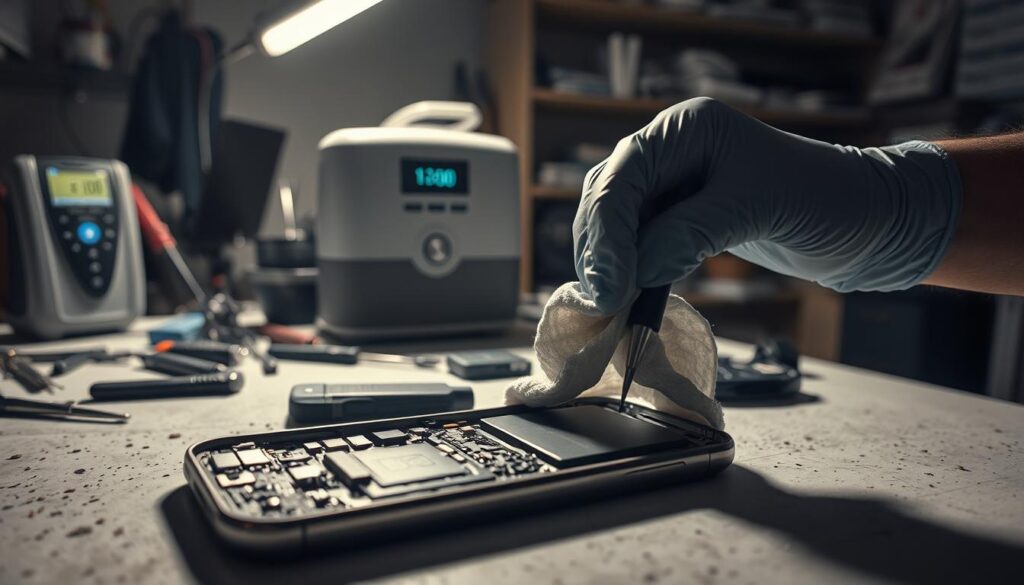
Trying both old ways and getting a pro can help fix your wet phone. This way, you might get it working again.
Tips to Prevent Future Water Damage
Keeping your phone safe starts with preventing water damage. While accidents can happen, being proactive helps a lot.
Using a waterproof case is a simple yet effective way to protect your phone. These cases keep your device dry, even when submerged. This is great whether you’re at the beach or caught in the rain.
Using Waterproof Cases
Waterproof cases come in many styles and materials, offering different levels of protection. Think about how you’ll use your phone when choosing a case. For water sports, look for cases made for underwater use.
High-quality waterproof cases from popular brands offer more than just water protection. They also have features like shock resistance and screen protection.
Keeping Your Phone Away from Water
Using a waterproof case is just the start. Being careful about where you use your phone is also key. Stay away from water bodies like pools, bathtubs, or sinks. Even a small splash can harm your device.
If you must use your phone near water, do it carefully. Use a phone holder or keep it far away. Also, be careful in rainy or humid weather to avoid water damage.
By following these tips, you can greatly lower the chance of phone water damage. This keeps your device working well and safe to use.
If you’ve had water damage before, combining prevention with water removal phone knowledge is very helpful.
When to Seek Professional Help
DIY fixes can help your phone after water damage. But, there are times when you need a pro. Knowing when to stop DIY is key to avoid more harm.
Signs That You Should Consult a Professional
If your phone still has problems after drying, like corrosion or won’t turn on, get professional help. Also, if you see internal damage or unusual smells, it’s time to call a pro.
As
“The longer you wait, the more likely it is that corrosion will set in, causing irreversible damage.”
This quote shows why acting fast is crucial when dealing with water damage.
What to Expect During Professional Repair
When you take your phone to a pro for water damage repair, expect a detailed check. The tech will figure out how bad the damage is and what to do next.
The repair cost depends on the damage and what’s needed. Always ask for a quote first to avoid surprises.
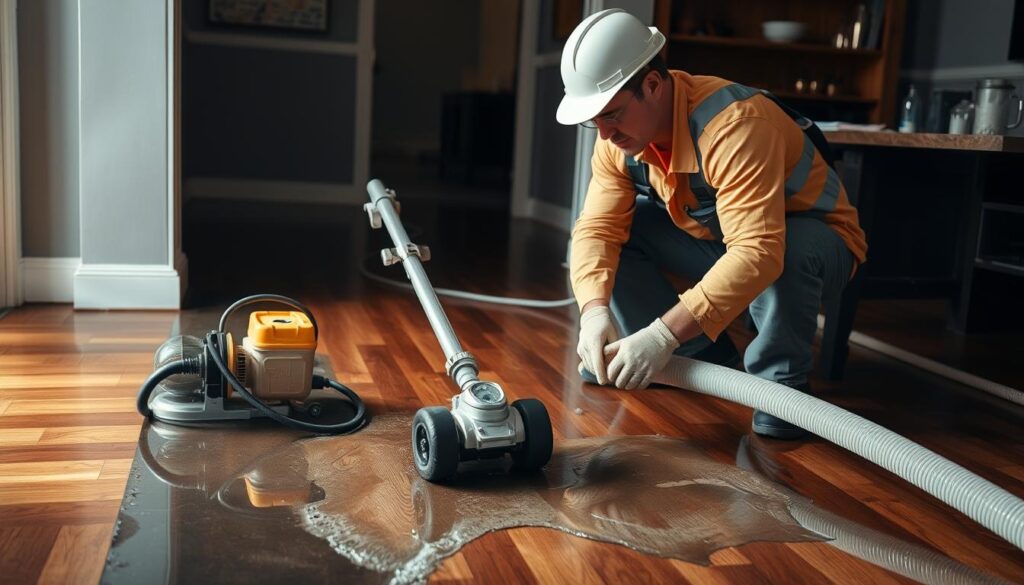
In summary, DIY fixes are good, but knowing when to get professional help is key. Recognizing when you need an expert and knowing what to expect can help you make the best choice for your phone.
Other Creative Solutions for Water Removal
People have found many creative ways to dry out their phones, besides just sound. They’ve tried different DIY hacks and tips from others. These methods are worth checking out.
DIY Hacks That Have Worked for Some Users
Some users have found success with unusual methods. For example, using silica gel packets or uncooked rice to soak up moisture is common. But, it’s important to remember these methods might not be safe for your phone.
Another trick is to use a hairdryer on a cool setting to dry the phone slowly. Make sure not to use hot air, as it can push water deeper into the phone.
Community-Driven Tips and Tricks
The online community has shared many tips. They suggest using desiccants or putting the phone in a dry, warm place to dry it out. Some also recommend using a vacuum cleaner to remove water, but be careful not to damage the phone’s inside.
| Method | Description | Caution |
|---|---|---|
| Silica Gel Packets | Absorb moisture effectively | Avoid ingesting; keep away from children |
| Uncooked Rice | Commonly used for drying | Dust can enter phone’s openings |
| Cool Hairdryer Setting | Gently evaporates water | Avoid hot air to prevent further damage |
While these creative solutions can be useful, it’s best to see a professional if your phone is badly damaged.
Conclusion: The Feasibility of Sound for Water Removal
Using sound to remove water from a phone is a new idea that works well. It’s not perfect, but it’s a good way to dry a wet phone.
Effective Phone Care
Knowing how sound helps remove water from phones is key. It helps you avoid water damage risks. With good phone care, you can use your phone without worry.
Staying Informed
Keeping up with the latest in phone water damage recovery is important. It helps your phone last longer. Being informed means you can protect your phone and keep it working great.
FAQ
What is the best way to dry out a phone that has been submerged in water?
To dry a wet phone, act fast and use several methods. Try sound frequencies, desiccants, or just air drying. Always wait until it’s dry before turning it on or charging it to avoid more harm.
Can sound frequencies really help remove water from a phone?
Yes, sound can help by vibrating water out of your phone. But, how well it works depends on the sound type, volume, and how wet the phone is.
What are the signs that my phone has water damage?
Look for corrosion, short circuits, and malfunctioning parts. Also, check for visible water or moisture inside. If you see these signs, act fast and get help if needed.
How can I prevent water damage to my phone in the future?
Use a waterproof case and stay aware of your surroundings. Keep your phone dry and away from water. Choose water-resistant phones and be careful near water to avoid damage.
What are the limitations of using sound to remove water from a phone?
Sound methods have limits, like the sound type and volume needed. They might not work for severe damage or complex phones. Be careful not to harm your phone’s parts.
When should I seek professional help for water damage repair?
Get professional help if you see ongoing damage, corrosion, or need complex repairs. They can fix your phone and make it work like new again.
Can I use DIY hacks to remove water from my phone?
Some DIY tricks might work, but be careful not to cause more harm. Use items like desiccants carefully and follow the right steps to avoid damage.
How can I generate the right sound frequencies to remove water from my phone?
Use online tools, apps, or special devices to create the right sounds. Make sure to use the correct frequency and volume to protect your phone’s inside.
